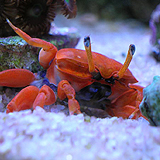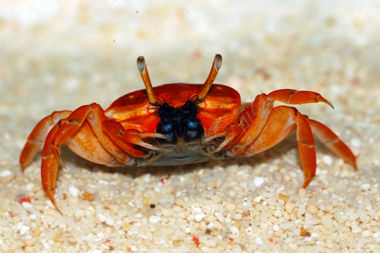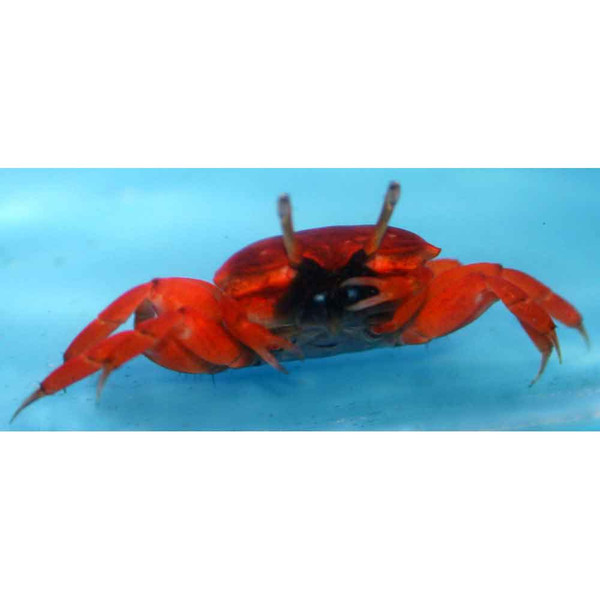Red Burrowing Crab
Are you fascinated by the vibrant colors and unique behaviors of crabs? Look no further than the red burrowing crab! These fascinating creatures are a popular choice among avid aquarists, but their unique needs can make them a challenge to care for without the proper knowledge. In this post, we'll explore the ins and outs of red burrowing crab care and provide helpful tips for keeping these creatures happy and healthy.
Pain Points of Red Burrowing Crab Care
Without proper care and attention, red burrowing crabs can suffer from a variety of health issues. These issues can range from minor infections to major illnesses that can be fatal to your crab. Some potential pain points to be aware of include:
- Difficulty meeting the specific temperature and humidity needs of the crab's environment
- Feeding the crab a varied and nutritional diet that meets their unique dietary needs
- Preventing bacterial and fungal infections that can be common in crabs
- Maintaining a clean and healthy environment to prevent illness and disease
Answering Your Questions About Red Burrowing Crab Care
Now that we've discussed some of the challenges that come with red burrowing crab care, let's address some of your most common questions about these fascinating creatures.
What is the Ideal Habitat for Red Burrowing Crabs?
Red burrowing crabs come from coastal areas in the wild, so they need an environment that mimics this natural habitat to thrive. The ideal habitat for a red burrowing crab should include:
- A sand or mud substrate that the crab can burrow into for shelter
- A consistent temperature range of 75-85°F
- Humidity levels of 70-80%
- A variety of structures and hiding places for the crab to explore
What Do Red Burrowing Crabs Eat?
Red burrowing crabs are omnivores, which means they eat both plant and animal matter. In captivity, it's important to offer a varied diet that includes:
- Commercial crab food pellets or flakes
- Protein sources such as brine shrimp, krill, and bloodworms
- Vegetables such as green beans, carrots, and spinach
- Fruits such as apples, bananas, and mangos
How Can I Maintain a Clean Environment for My Red Burrowing Crab?
Cleanliness is essential to keeping your red burrowing crab healthy. Some tips for maintaining a clean environment include:
- Regularly removing uneaten food and debris from the tank
- Performing partial water changes every 1-2 weeks to keep water quality high
- Keeping a close eye on your crab for signs of illness or infection
What Are Some Common Health Issues That Red Burrowing Crabs Face?
Red burrowing crabs are prone to a variety of health issues, including:
- Fungal infections
- Bacterial infections
- Shell rot
- Mites or ticks
A Personal Experience with Red Burrowing Crab Care
I've been keeping red burrowing crabs for several years now, and I have to say, they're one of my favorite creatures to care for. Watching them burrow into the substrate and explore their environment is truly fascinating. However, I have run into some challenges along the way. For example, I struggled to maintain consistent humidity levels in my tank at first, which led to some health issues with my crabs. But with the right tools and knowledge, I was able to create a healthy and thriving environment for my crabs.
Caring for Your Red Burrowing Crab: Tips and Tricks
If you're interested in caring for a red burrowing crab, here are some additional tips and tricks to keep in mind:
- Invest in a hygrometer to keep track of humidity levels in your tank
- Provide your crab with a variety of hiding places and structures to explore
- Change out the substrate in your crab's tank every 6-12 months to prevent the buildup of bacteria and other harmful substances
- Keep a close eye on your crab for any signs of illness or injury, and seek veterinary care if necessary
Question and Answer
Q: Can I keep red burrowing crabs with other species in my tank?
A: While it's possible to keep red burrowing crabs with other species, it's important to choose tank mates carefully. Fish and other creatures that are too big or aggressive can pose a threat to your crab, while smaller creatures can be seen as prey. Some good tank mates for red burrowing crabs include snails and shrimp
Q: How can I tell if my red burrowing crab is male or female?
A: Male red burrowing crabs have larger claws with a more triangular shape, while female crabs have smaller, rounder claws. Additionally, male crabs tend to be slightly larger than females.
Q: Do red burrowing crabs need a heater in their tank?
A: Yes, red burrowing crabs need a consistent temperature range of 75-85°F to thrive. A heater can help you maintain this temperature range in your tank.
Q: How often should I feed my red burrowing crab?
A: Red burrowing crabs should be fed once or twice a day, depending on their size and age. It's important to offer a variety of food options to ensure they're getting the nutrients they need.
Conclusion
Caring for a red burrowing crab requires time, effort, and attention to detail, but with the right knowledge and tools, it can be a rewarding and fascinating experience. By addressing common pain points, answering your most pressing questions, and sharing helpful tips from personal experience, we hope this guide has provided you with the tools you need to provide your red burrowing crab with the best possible care.
Gallery
Red Burrowing Crab

Photo Credit by: bing.com / crab burrowing red reef crabs safe reefs
Does Anyone Have Any Experience With A "Red Burrowing Crab"? Does It

Photo Credit by: bing.com / burrowing reeftank
Red Burrowing Crab - Uca Spp.

Photo Credit by: bing.com / crab burrowing
Red Burrowing Crab - Uca Sp. | That Fish Place

Photo Credit by: bing.com / uca site
Look At This Adorable Red Burrowing Crab! Available In The Saltwater

Photo Credit by: bing.com / crab burrowing saltwater